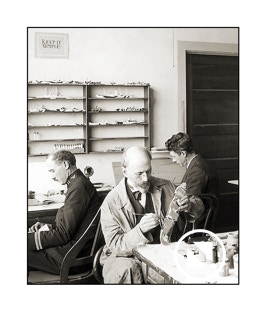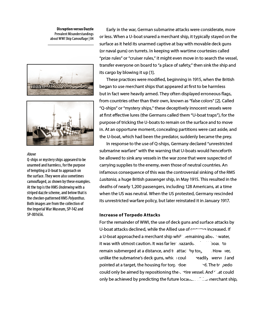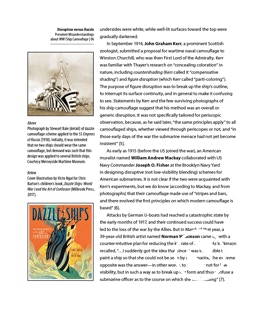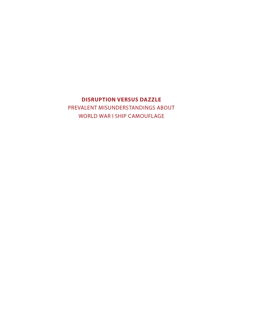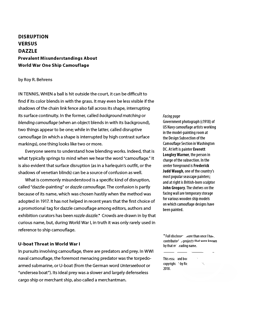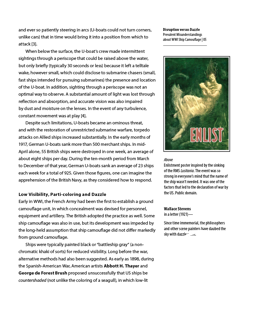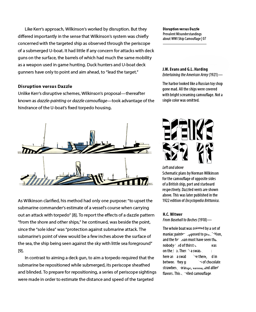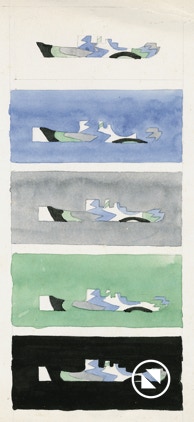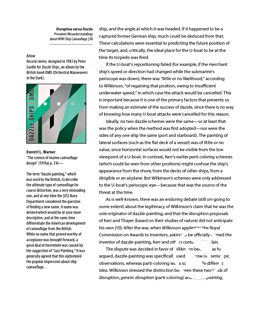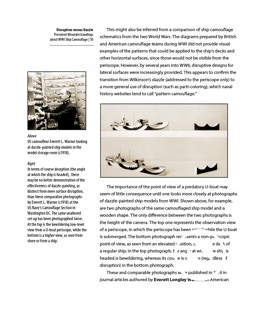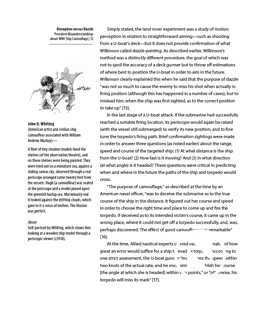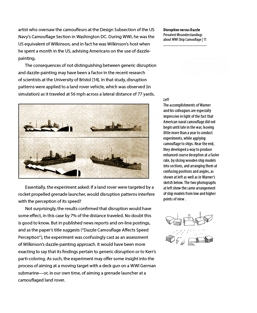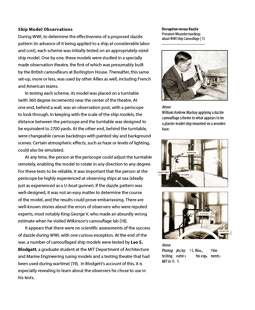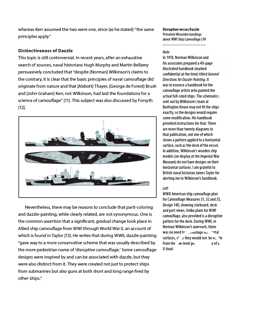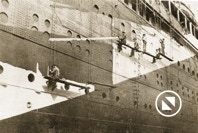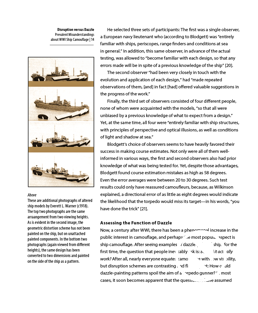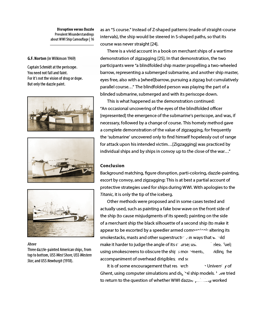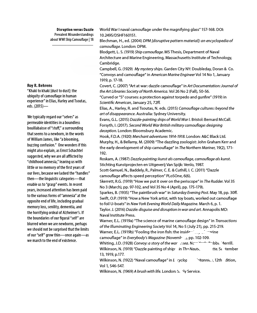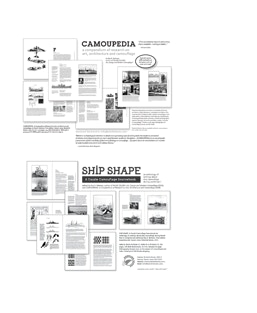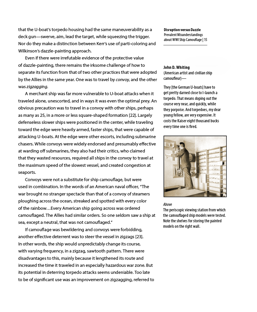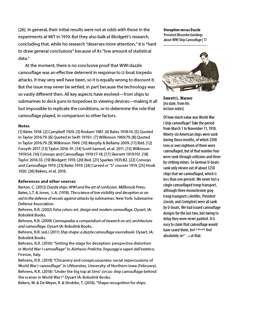CAMOUPEDIA
This essay was privately published in October 2018 as a full-color laser-printed booklet.
It can be read online on this webpage simply by clicking on each single page as reproduced on the right. Any page that has a magnifying icon will enlarge on screen by clicking.
•••
THOSE WHO WERE not fortunate enough to see the docks at one of our great ports during the war may imagine the arrival of a convoy—or, as frequently occurred, two at a time—of these painted ships, and the many miles of docks crowded with vessels of all sorts, from the stately Atlantic liner to the humbler craft bearing its cargo of coal or palm oil, each resplendent with a variety of bright-hued patterns, up-to-date designs of stripes in black and white or pale blue and deep ultramarine, and earlier designs of curves, patches, and semicircles. Take all these, huddle them together in what appears to be hopeless confusion, but which in reality is perfect order, bow and stern pointing in all directions, mix a little sunshine, add the varied and sparkling reflections, stir the hotchpotch up with smoke, life, and incessant movement, and it can safely be said that the word “dazzle” is not far from the mark.
Hugh Hurst in “Dazzle painting in war-time” in International Studio (September 1919).
•••
TO DISGUISE steamships or give them low visibility an interesting experiment in marine painting is being made off the Bay Ridge district in Brooklyn. There a British steamship is being done over with alternating stripes of black and gray, each about four feet wide. Passengers aboard ferryboats have been watching the transformation and noting the difference in the distance which they can descry the vessel in its new camouflage. The smokestack is painted in squares and the hull in stripes.
Anon “‘Camouflage Steamship to Escape Sub Detection” in the Bourbon News (Paris KY).
Above Chromolithographic plan for ship camouflage by US Navy camoufleurs.
[AROUND 1915] Abbott Thayer…made a number of studies with ship models. On one occasion he noticed that a partly painted model appeared to be headed in the wrong direction. His further experimentation led to a system of course- and type-deception which used misleading painted patterns to falsify real perspective and natural lines of construction. Such strong contrasting deception patterns, when carefully designed by good artists, could make a ship appear to be headed on any course desired, regardless of the ship’s actual course.
D.R.E. Brown in Ship Concealment Camouflage Instructions. Washington DC: Bureau of Ships, US Navy, 1963, p. 130.
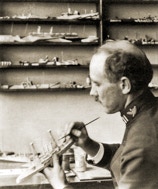
Disruption versus Dazzle:
Prevalent Misunderstandings
About World War I Ship Camouflage
An Essay by Roy R. Behrens. Copyright © 2018. All rights reserved.
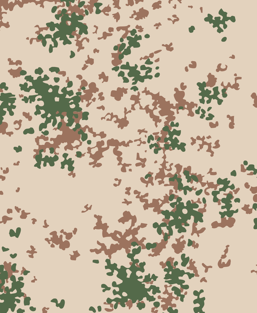
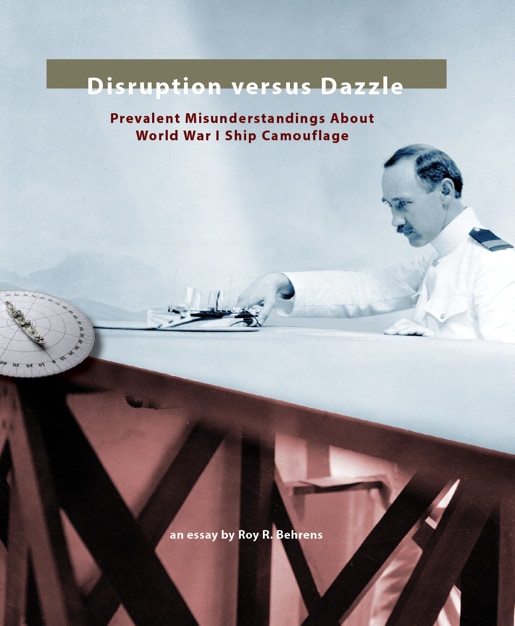
Above Watercolor sketches by Abbott H. Thayer of disruptive patterns in ship camouflage (c1915).
WHEREAS concealment has to do mainly with motionless objects, distortion is concerned for the most part with objects in motion. The moving object cannot, as a rule, be hidden, but it can be made less definite, more puzzling, a more ‘tricky’ and difficult target, by certain arrangements of color and pattern. This my father and I pointed out in 1909 in our book Concealing Coloration in the Animal Kingdom; and we there used the terms ‘dazzle’ and ‘dazzling’ very much as they have since been used in connection with the camouflage of ships.
Gerald H. Thayer “Camouflage in Nature and War” in Brooklyn Museum Quarterly. Vol 10, 1923, p. 161.
Above Photograph of camouflage being applied to ship (c1918).
IN ORDER to understand more readily the science of illusion, it is necessary to set aside for the moment your customary interpretation of the word fact. Let us take for example a wallpaper pattern of regular recurrent design. Is it not true that you are in the habit of thinking of the pattern as uniform and equal throughout—every rose just as red as its fellow, and every repetition of the pattern as measuring exactly the same number of inches?
It is conceded that those are the actual facts, and that such is wallpaper as it is. However, it is hardly an exaggeration to say that to the human eye no such pattern exists. If a room were papered with a pattern of recurrent design, and if it were possible to take a photograph with a filter which would eliminate everything but the pattern, it would be quite possible to reconstruct the room from such a photograph and a piece of wallpaper.
Every change in the direction of the walls—every corner and projection—would all be indicated by an alteration in the apparent size and shape of our units of pattern. When you have once thoroughly grasped this idea, marine camouflage holds no secrets for you.
Everett L. Warner “The Science of Marine Camouflage Design” in Transactions of the Illuminating Engineering Society. Vol 14 No 5. July 21, 1919, pp. 215-219.



